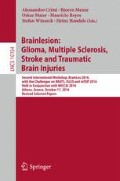Abstract
Template matching is a popular approach to computer-aided detection of brain lesions from magnetic resonance (MR) images. The outcomes are often sufficient for localizing lesions and assisting clinicians in diagnosis. However, processing large MR volumes with three-dimensional (3D) templates is demanding in terms of computational resources, hence the importance of the reduction of computational complexity of template matching, particularly in situations in which time is crucial (e.g. emergent stroke). In view of this, we make use of 3D Gaussian templates with varying radii and propose a new method to compute the normalized cross-correlation coefficient as a similarity metric between the MR volume and the template to detect brain lesions. Contrary to the conventional fast Fourier transform (FFT) based approach, whose runtime grows as \( O\left( {N\,\log N} \right) \) with the number of voxels, the proposed method computes the cross-correlation in \( O\left( N \right) \). We show through our experiments that the proposed method outperforms the FFT approach in terms of computational time, and retains comparable accuracy.
Access this chapter
Tax calculation will be finalised at checkout
Purchases are for personal use only
Notes
- 1.
We ran the experiments on a Linux computing cluster. Although we used MATLAB with the singleCompThread option, it still multithreaded the codes on multiple cores. Therefore, here for each experiment we report the total time spent by the cores (CPU time), as opposed to the real-world time elapsed between the start and end times of the code (wall time).
References
Tourassi, G.D., Vargas-Voracek, R., Catarious, D.M., Floyd, C.E.: Computer-assisted detection of mammographic masses: a template matching scheme based on mutual information. Med. Phys. 30, 2123–2130 (2003)
Lochanambal, K.P., Karnan, M., Sivakumar, R.: Identifying masses in mammograms using template matching. In: Proceedings of the Second International Conference on Communication Software and Networks (ICCSN 2010), pp. 339–342 (2010)
Osman, O., Ozekes, S., Ucan, O.N.: Lung nodule diagnosis using 3D template matching. Comput. Biol. Med. 37, 1167–1172 (2007)
Moltz, J.H., Schwier, M., Peitgen, H.-O.: A general framework for automatic detection of matching lesions in follow-up CT. In: Proceedings of the IEEE International Symposium on Biomedical Imaging: From Nano to Macro (ISBI 2009), pp. 843–846 (2009)
Wang, P., DeNunzio, A., Okunieff, P., O’Dell, W.G.: Lung metastases detection in CT images using 3D template matching. Med. Phys. 34, 915–922 (2007)
Warfield, S.K., Kaus, M., Jolesz, F.A., Kikinis, R.: Adaptive, template moderated, spatially varying statistical classification. Med. Image Anal. 4, 43–55 (2000)
Ambrosini, R.D., Wang, P., O’Dell, W.G.: Computer-aided detection of metastatic brain tumors using automated three-dimensional template matching. J. Magn. Reson. Imaging 31, 85–93 (2010)
Farjam, R., Parmar, H.A., Noll, D.C., Tsien, C.I., Cao, Y.: An approach for computer-aided detection of brain metastases in post-Gd T1-W MRI. Magn. Reson. Imaging 30, 824–836 (2012)
Yang, S., Nam, Y., Kim, M.-O., Kim, E.Y., Park, J., Kim, D.-H.: Computer-aided detection of metastatic brain tumors using magnetic resonance black-blood imaging. Invest. Radiol. 48, 113–119 (2013)
Wang, X.-F., Gong, J., Bu, R.-R., Nie, S.-D.: A 3D adaptive template matching algorithm for brain tumor detection. In: Ma, S., Jia, L., Li, X., Wang, L., Zhou, H., Sun, X. (eds.) LSMS/ICSEE 2014. CCIS, vol. 461, pp. 50–61. Springer, Heidelberg (2014). doi:10.1007/978-3-662-45283-7_6
Muñoz, A., Ertlé, R., Unser, M.: Continuous wavelet transform with arbitrary scales and O(N) complexity. Sig. Process. 82, 749–757 (2002)
Kogan, S.: A note on definite integrals involving trigonometric functions (1999). http://mathworld.wolfram.com/SincFunction.html
Cooley, J.W., Tukey, J.W.: An algorithm for the machine calculation of complex fourier series. Math. Comput. 19, 297–301 (1965)
Acknowledgments
Support for this research was provided in part by the National Institute of Diabetes and Digestive and Kidney Diseases (K01DK101631, R21DK108277), the National Institute for Biomedical Imaging and Bioengineering (P41EB015896, R01EB006758, R21EB018907, R01EB019956), the National Institute on Aging (5R01AG008122, R01AG016495), the National Institute for Neurological Disorders and Stroke (R01NS0525851, R21NS072652, R01NS070963, R01NS083534, 5U01NS086625), the National Institutes of Health (NIH) Blueprint for Neuroscience Research (5U01-MH093765; part of the multi-institutional Human Connectome Project), and was made possible by the resources provided by the NIH Shared Instrumentation Grants (S10RR023401, S10RR019307, and S10RR023043). Additionally, SK was supported by a Fulbright-Nehru Doctoral Research Fellowship (Award no: 2098/DR/2015-2016), and CC was supported by the DAE-Young Scientist Research Award Scheme (2013/36/38-BRNS/2350, dt.25-11-2013) by Board of Research in Nuclear Sciences (BRNS), Dept. of Atomic Energy, Govt. of India. BF has a financial interest in CorticoMetrics, a company whose medical pursuits focus on brain imaging and measurement technologies. BF’s interests were reviewed and are managed by Massachusetts General Hospital and Partners HealthCare in accordance with their conflict of interest policies.
Author information
Authors and Affiliations
Corresponding author
Editor information
Editors and Affiliations
Rights and permissions
Copyright information
© 2016 Springer International Publishing AG
About this paper
Cite this paper
Koley, S., Chakraborty, C., Mainero, C., Fischl, B., Aganj, I. (2016). A Fast Approach to Automatic Detection of Brain Lesions. In: Crimi, A., Menze, B., Maier, O., Reyes, M., Winzeck, S., Handels, H. (eds) Brainlesion: Glioma, Multiple Sclerosis, Stroke and Traumatic Brain Injuries. BrainLes 2016. Lecture Notes in Computer Science(), vol 10154. Springer, Cham. https://doi.org/10.1007/978-3-319-55524-9_6
Download citation
DOI: https://doi.org/10.1007/978-3-319-55524-9_6
Published:
Publisher Name: Springer, Cham
Print ISBN: 978-3-319-55523-2
Online ISBN: 978-3-319-55524-9
eBook Packages: Computer ScienceComputer Science (R0)

